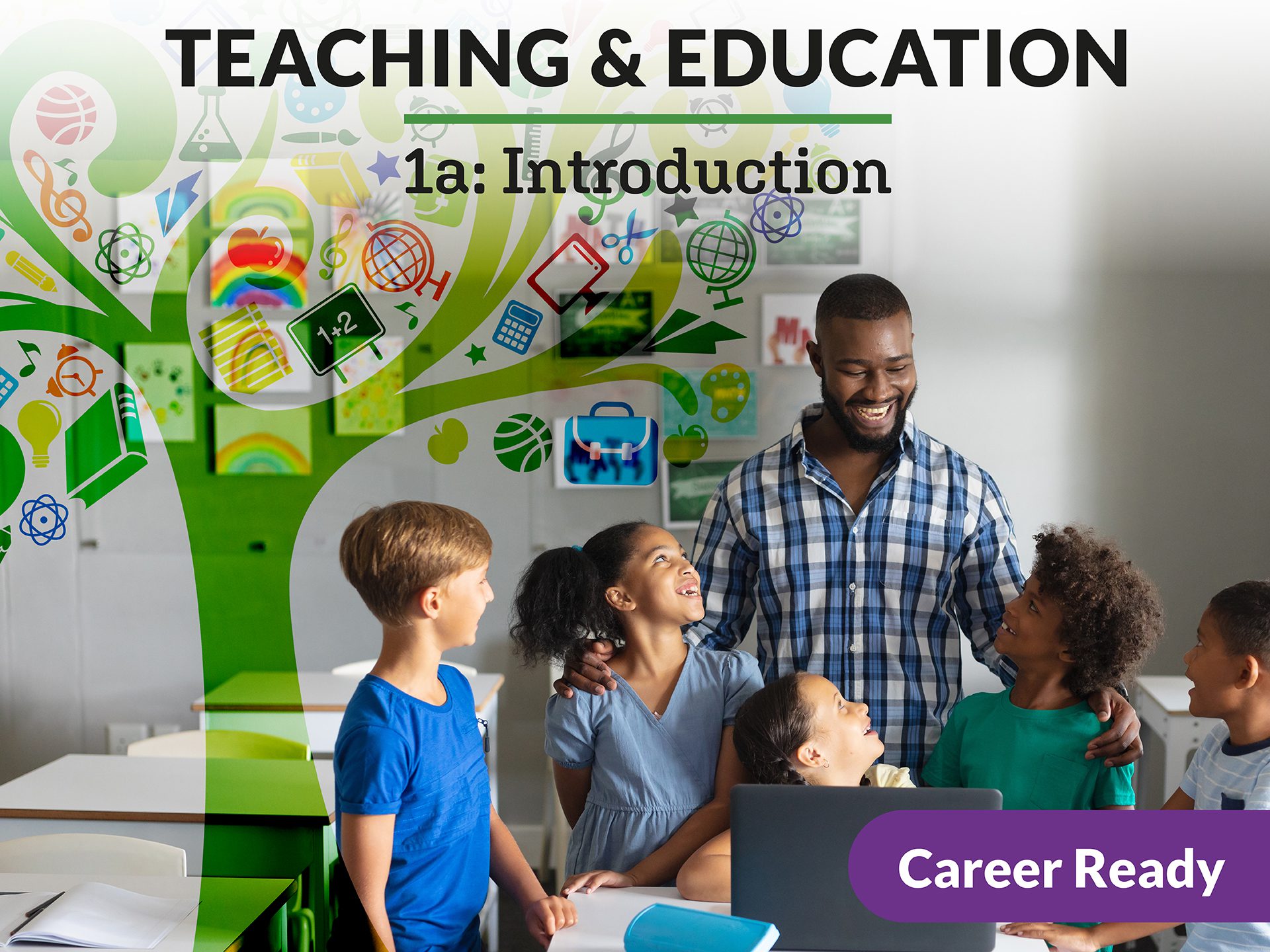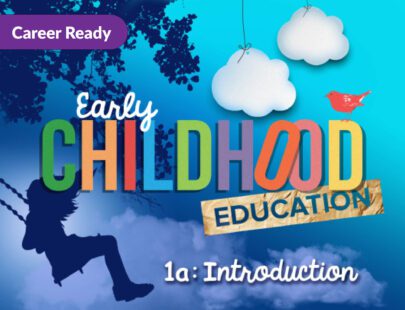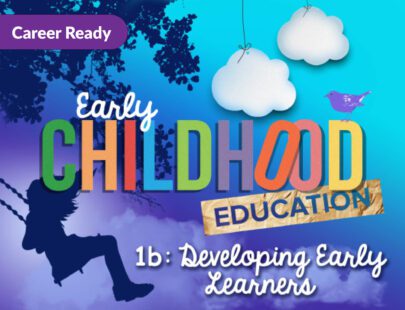
Teaching & Education 1a: Introduction
Do you love to learn? Do you enjoy sharing what you know with others? Teaching might be the perfect career for you! Teaching is so much more than a job. This is an amazing profession where every day is an opportunity to ignite curiosity in young minds. Explore what it takes and the skills needed to be a dynamic and effective classroom teacher. From school climate to educational policies, get ready to discover the various components that impact a student’s success. Plus, unlock tips and tricks that bring the classroom to life for today’s diverse and tech-savvy students!
Units at a Glance
Unit 1: So, You Want to Be a Teacher
Do you remember your favorite teacher? What was it that made them so good? Being an educator, particularly a teacher, is a very rewarding profession. Endless opportunities to serve and help students, their families, and community members allow you to contribute to helping make the world a better place. Also, the skills needed to be a successful teacher will make you a lifelong learner. Are you ready for class to begin?
What will you learn in this unit?
- Explain the characteristics and skills needed to be a successful educator
- Differentiate between the professional responsibilities of early childhood, childhood, and secondary educators
- Identify the types of classrooms in which teachers serve
- Describe the importance of building community to enhance collaborative relationships in your school
Unit 2: Learning Environments and Contributing Factors
Schools come in all shapes and sizes. Although schools may be managed differently, each works to prepare students for life after high school. No matter the type of school, they all need funding and resources to operate and help students succeed. School climate and culture are also critical to student success. Let’s take a deep dive and explore school environments.
What will you learn in this unit?
- Categorize various types of schools
- Explain the importance of school funding and how it occurs
- Describe factors that influence school climate
- Identify societal, economic, and technological factors that influence schools
Unit 3: Educational Foundations
Have you ever wondered how schooling in the United States began? What did the first school look like? Did all children attend school together like they do today? Let’s explore these questions and dig into the history of education in the United States. We will examine some of the important influencers, laws, and movements that helped shape our education system into what it is today.
What will you learn in this unit?
- Identify key historical events throughout the history of mass education in the United States
- Describe the contribution of important figures to US education
- Examine the influence of key legislation on educational practices
- Analyze the impact of educational policy on teachers and students
Unit 4: Teachers and Students of Today
Can you imagine a time when all of schooling was in person? Have you ever had to handwrite a paper? It is hard to believe how much has changed. Change in the classroom is driven not just by laws and social movements. Consider new technologies and the COVID-19 pandemic, both of which have shaped education around the world. The evolution of education, especially public education, has impacted how teachers instruct today’s students and how children learn. Ready to dive into our changing world?
What will you learn in this unit?
- Describe the national and global impacts of education
- Explain how the evolution of education has changed teaching and learning
- Identify the factors that contribute to the use of online learning
- Analyze the advantages and disadvantages of online learning
Unit 5: Who Will You Be Teaching?
Think about your school for a minute. How would you describe the student body? Students represent a diverse array of individuals who speak different languages, are of various ages, and come from a range of racial and ethnic backgrounds. Students also have varying learning needs and are representative of different socio-economic backgrounds. Despite these differences, every student needs and deserves the opportunity to learn so that they can reach their individual potential and have a good quality of life. Teachers play a crucial and unique role in the lives of students. By understanding how people develop and learn, teachers can create optimal learning environments to help students succeed.
What will you learn in this unit?
- Explain child development theories
- Identify the learning needs of preschool and elementary school students
- Describe the learning needs of middle and high school students
- Describe the learning needs of middle and high school students
Unit 6: Pathways to Teacher Training
Every professional career has different ways to get started in the field, and teaching is the same. Many people think they know what it takes to be a teacher because they’ve spent their lives as students watching teachers working at the front of their classrooms. How hard can it be? All it takes is knowledge of the subject area and an interest in kids, right? Turns out, there’s a little more to it—and more than one way to get there—than that.
What will you learn in this unit?
- Describe various teacher training pathways
- Outline post-training steps to becoming a teacher
- Identify various ways to pay for teacher training
- Distinguish between supervised learning experiences and professional development opportunities for pre-service and practicing teachers
Unit 7: Education Law and Ethics
Teachers’ actions need to be both ethical and in compliance with the law. While these two types of guidelines are different in many ways, they both serve to influence teacher actions and decision-making. Understanding the difference between the two, then taking a look at how these guidelines play out in scenarios where teachers spend time with students in and out of school, will help you better understand how being a teacher affects a person’s choices and conduct personally and professionally.
What will you learn in this unit?
- Describe ethics as they relate to the teaching profession
- Distinguish laws that guide or influence the teaching profession
- Interpret federal laws related to teaching and learning
- Explain the role and responsibilities of teachers in extracurricular activities
Unit 8: Other Movers and Shakers
Teachers interact with students all day long, and together they make up a large percentage of the participants in a learning landscape. There are, however, far more interested parties than just teachers and students in the field of education. Who are the other stakeholders? Here we will take a look at the community members within and beyond school communities who have interests in and commitments to the educational process. All these people have important contributions to make when it comes to education.
What will you learn in this unit?
- Differentiate between administrative, management, leadership, and supervisory positions in education
- Explain the purposes of teacher communication to internal stakeholders
- Explain the purposes of teacher communication to external stakeholders
- Describe the purposes of teacher participation in professional education organizations
- Evaluate the benefits and drawbacks of participation in a teacher union
Required Materials
Physical
- Video recording device
Software
- Word processing software
- Presentation software
Other
- Helper
- Teacher
Optional
- Art Supplies
- Audio recording device
- Construction paper
- Digital camera
- Graphic design software
- Poster board

